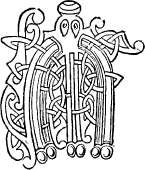
SECTION IV.
Maighin Digona

AIGHIN DIGONA was the name of a precinct of sanctuary secured by the law around the dwelling-house of every clansman, within which the owner and his family and property were inviolable. It was sometimes a cleared space the boundary of which was marked by trees or bushes; but whether thus perceptible to the eye or not did not affect its reality. The English saying that every Englishman's house is his castle, is an illustration of the spirit that prompted the maighin digona. The sanctuary varied in extent with the owner's rank. In the case of a bo-aire it extended as far as he, while sitting at his house, could cast a cnairsech. This is differently described as a spear and as a sledge-hammer. It was probably neither, but bore some resemblance to both. It consisted of a head of iron fastened on a wooden handle "twelve fists" in length.
The hand was commonly used as a standard of measure, being considered four inches across the palm at the roots of the fingers, six inches across at the thumb with the thumb extended. On the end of the wooden handle was a bocin (bokkeen) or horn fixed crosswise, just as the Irish peasants are to this day accustomed to fix bokkeens on the handles of the tools they use. One throw of this instrument determined the extent of the bo-aire's sanctuary, twice this for the aire-desa, and so on, the distance being doubled for each successive grade in the ascending scale. Four throws and three score (i.e. sixty-four throws) was the extent of the Rig-Tuatha's sanctuary. This is said to have equalled a thousand paces. In some districts the sanctuaries of chiefs were measured by the sound of a bell or the crow of a cock. A provincial king might, if he pleased, assert sanctuary over the whole extent of the plain on which his dun stood. The bards and brehons appear to have had the same extent of sanctuary as the rig-tuatha. In Christian times bishops appear to have had the same extent of sanctuary; whence, perhaps, it may be inferred that in pagan times the arch-druids were similarly favoured. An ollamh's wand carried round and over a fugitive anywhere protected him as did the maighin digona.
The owner of a maighin digona was empowered to extend its protection to a stranger flying from the hue-and-cry; but no stranger could effectually avail of it without the owner's consent. If this consent was obtained, the effect of the extension was to save the stranger from the violent hands of his pursuers. They could not pursue or meddle with him further, but were obliged to resort to the legal methods of bringing him to justice. They could summon him before a brehon, and against this the sanctuary did not protect him at all. If they violated the protection by continuing the pursuit and abusing the fugitive, they incurred liability to the owner of the maighin digona.
The owner of a sanctuary was bound not to allow a fugitive to escape. "He who lets a criminal escape is himself a culprit." He might avert violence, but not defeat justice. When asserting his sanctuary he was bound to give the pursuer a guarantee that he would not allow the fugitive to escape; and if no actual guarantee was given the law presumed a guarantee, and held the owner of the sanctuary responsible for the original offence if he allowed the prisoner to escape.

